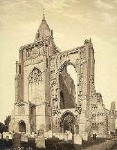
Crowland Abbey
Crowland Abbey, located deep in the Lincolnshire fens of England, was once a center for medieval religious life. Today, however, it lies mostly in ruins. A few quatrefoil window carvings and undamaged statues provide a sense of the building's former glory, but the abbey itself is less well known for its artwork than it is for an outrageous historical hoax that its former inhabitants once perpetrated.
The abbey dates back to the early ninth century. For centuries monks lived a quiet, solitary existence there, tending their crops and spending long hours in worship. But despite their devotion to solitude, the monks were not immune to the intrusions of the outside world. In particular, they had to guard against a steady stream of legal threats to the abbey property. These threats peaked during the early fifteenth century when a neighboring abbey claimed a portion of Crowland's lands as their own, resulting in a case that was brought to court in 1413. To prove that they had sole claim to the abbey's lands, the Crowland monks presented the court with a volume known as the
Historia Crowlandensis (or History of Crowland), that was a string of historical land charters woven together into a general history of the abbey. The History and charters were accepted as legitimate, the Crowland monks won their case, and the abbey, for the moment, was safe.
But for later generations of scholars, the fact that the Crowland monks won their case was less interesting than was the History of Crowland itself, since the document provided a rare written record of centuries of medieval church life. By the 18th century the History had become a widely quoted source for information about medieval monasteries. It was only in the nineteenth century that historians began to realize that something about the History was fishy.
Their first clue was the names. They noticed that the History referred to numerous places and historical figures using fourteenth-century terms, even in passages that were supposedly written in the tenth century. As they studied the document more closely, historians found even more discrepancies. For instance, it referred to monks who had allegedly studied at Oxford University in years before the University existed. It mentioned the construction of a triangular bridge in the tenth century, even though triangular bridges weren't invented until the fourteenth century. And finally, and most bizarrely, it credited the monks of the abbey with remarkable health, for according to the History the monks had regularly attained ripe old ages such as 115, 142, and even 148. Either the History was a fraud, historians realized, or there was something very special in the water those monks were drinking. Historians decided it was fraud.
To the monks' credit, the deception worked, but their luck didn't hold out forever. The next century Henry VIII decided to dissolve England's monasteries. To avert this fate, the Crowland monks tried to win over the King's agents with a gift of sumptuous fish, but this time their ploy didn't work. The abbey was dissolved in 1539.
Links and References
- Tout, T.F. (1920). Mediaeval Forgers and Forgeries. Longmans, Green & Company. Manchester, United Kingdom.


Comments